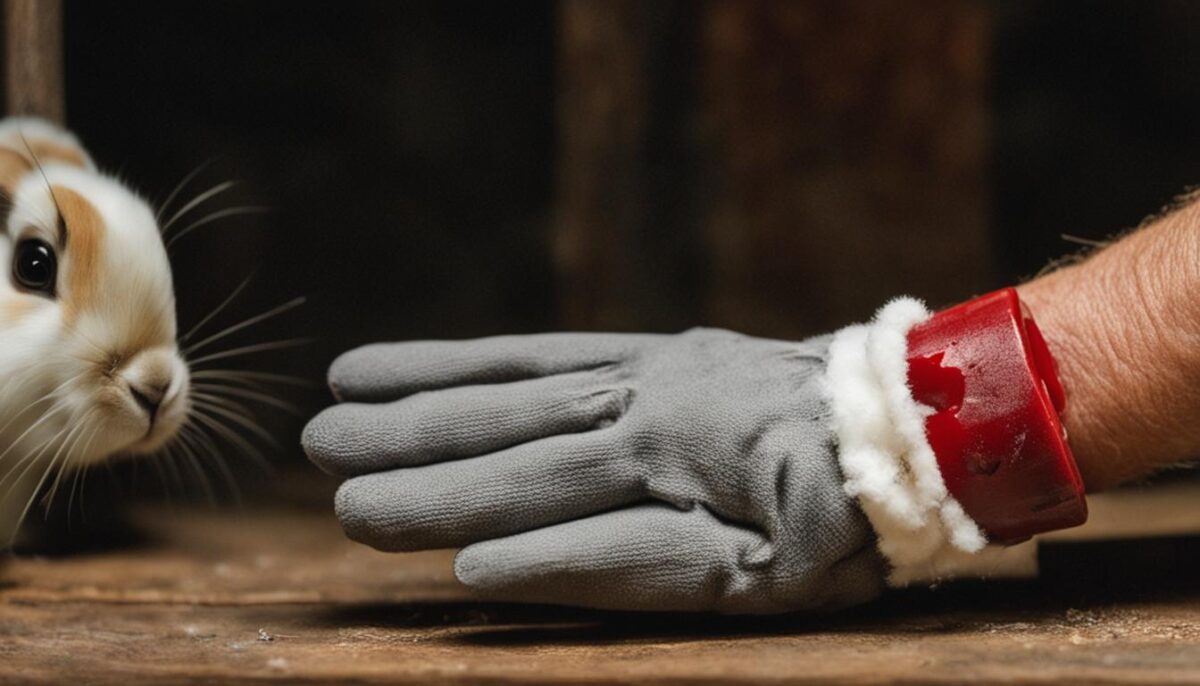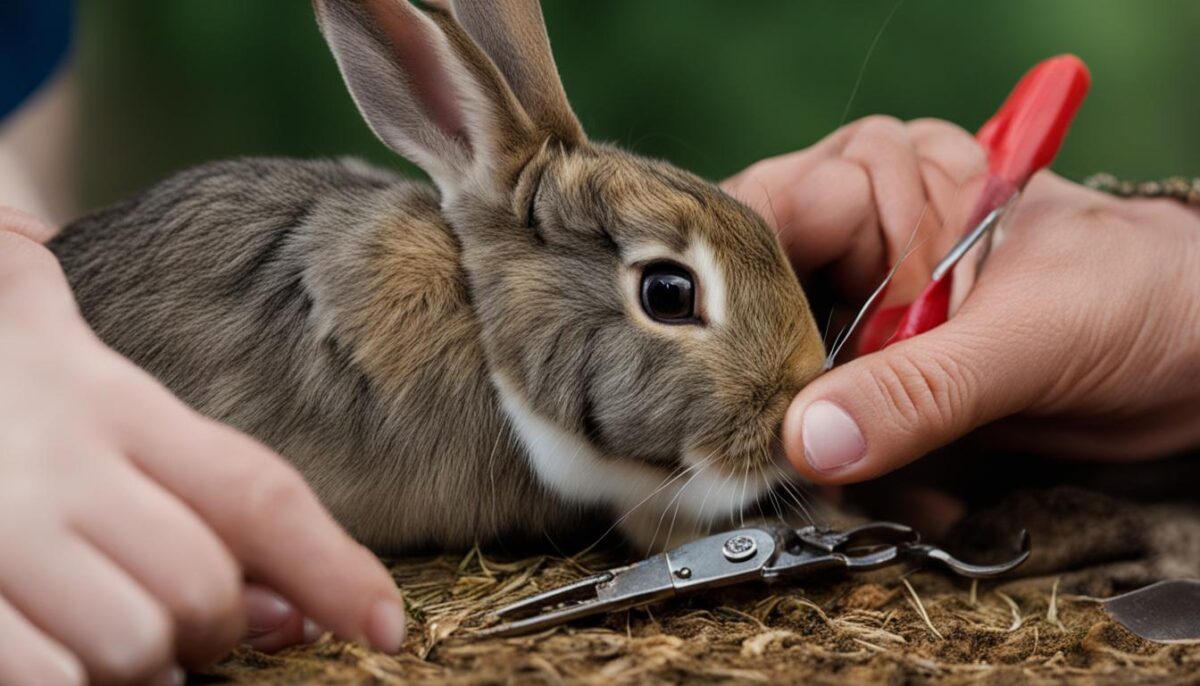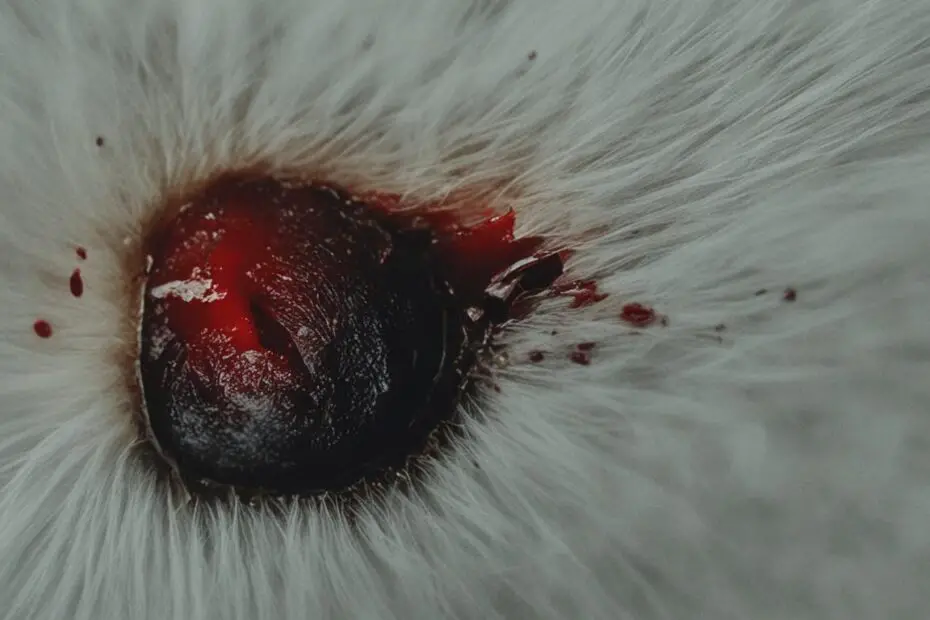When a rabbit’s nail is torn or bleeding, it can be a cause for concern. However, it’s important to know that this is a common and easily treatable injury. By taking immediate action and providing proper care, you can help your rabbit heal quickly and prevent further complications.
To stop the bleeding in a rabbit’s nail, the first step is to apply gentle pressure to the toe. This helps slow down the blood flow and allows the clotting process to begin. You can use a clean cloth or your fingers to apply the pressure. Remember to remain calm and reassure your rabbit throughout the process.
Next, you can use cornstarch or styptic powder to aid in stopping the bleeding. These substances help promote clotting and provide a barrier to prevent further bleeding. Apply a small amount directly to the bleeding area and gently press it in. Be careful not to apply too much pressure to avoid causing discomfort to your rabbit.
After the bleeding has stopped, it’s important to allow your rabbit to lick their wound. Rabbit saliva contains mild antibacterial properties, which can help keep the area clean and prevent infection. Monitor the nail for any signs of inflammation or infection, such as redness, swelling, or discharge. If you notice any of these signs, it’s best to consult a veterinarian for further evaluation and treatment.
It’s worth noting that most broken nails in rabbits do not require professional medical attention. With proper care and observation, the nail should heal on its own within a few days to a week. However, if the bleeding persists or the nail injury is severe, it’s always best to seek veterinary advice.
Key Takeaways:
- When a rabbit’s nail is torn or bleeding, apply gentle pressure to the toe to stop the bleeding.
- Use cornstarch or styptic powder to aid in clotting and prevent further bleeding.
- Allow your rabbit to lick their wound to help clean the area.
- Monitor the nail for signs of inflammation or infection.
- Most broken nails in rabbits heal on their own with proper care and observation.
Treating a Torn or Bleeding Rabbit Nail
When a rabbit’s nail is torn or bleeding, immediate action is necessary to stop the bleeding and provide appropriate care. Follow these steps to treat a rabbit’s nail injury:
1. Apply Pressure and Use Cornstarch or Styptic Powder
To stop the bleeding, apply gentle pressure to the affected nail using a clean cloth or gauze pad. This helps minimize blood flow and promotes clotting. If available, sprinkle a small amount of cornstarch or styptic powder on the nail to aid in the clotting process and accelerate healing.
2. Allow Rabbit to Lick the Wound
Once the bleeding has stopped, it’s beneficial to let the rabbit lick their wound. Rabbit saliva contains mild antibacterial properties, which can assist in cleaning the injured area and reducing the risk of infection. However, ensure that the rabbit does not excessively lick or chew the wound, as this may delay healing.
3. Monitor for Inflammation or Infection
After treating the torn or bleeding nail, it’s crucial to keep a close eye on the affected area. Watch for any signs of inflammation, such as redness, swelling, or heat. Additionally, look for signs of infection, such as pus or a foul odor. If any concerning symptoms arise, consult a veterinarian for further evaluation and treatment.
Most cases of broken or torn nails in rabbits will heal on their own without requiring professional medical attention. However, it’s essential to provide proper care and monitor the nail’s condition to ensure the rabbit’s well-being.

| Treatment Steps | Benefits |
|---|---|
| Applying pressure and using cornstarch or styptic powder | Stops bleeding and promotes clotting |
| Allowing the rabbit to lick the wound | Aids in cleaning and reduces the risk of infection |
| Monitoring for inflammation or infection | Ensures timely intervention if complications arise |
Preventing Nail Injuries in Rabbits
While nail injuries can happen to rabbits, there are steps you can take to prevent them. Regularly trimming your rabbit’s nails can help maintain a proper length and prevent them from getting too long and prone to snagging.
Proper nail trimming techniques and tools can help prevent accidental injuries.
When trimming the nails, it’s important to avoid cutting too close to the quick, which is the vein inside the nail. This will help prevent bleeding and discomfort for your rabbit.
Avoiding towels or blankets with loops or holes can reduce the risk of a nail getting caught and torn.
By following these preventive measures, you can minimize the risk of nail injuries in your beloved rabbits.

Preventive Measures for Rabbit Nail Care
| Preventive Measures | Description |
|---|---|
| Regular Nail Trimming | Trimming your rabbit’s nails every 2 months can help prevent overgrowth and reduce the chances of nails snagging or tearing. |
| Avoid Cutting Too Close to the Quick | Ensure you do not cut too close to the quick, which is the vein inside the nail. This will help prevent bleeding and discomfort for your rabbit. |
| Use Proper Nail Trimming Techniques and Tools | Using high-quality nail clippers and following proper trimming techniques can ensure a safe and effective nail care routine for rabbits. |
| Avoid Towels or Blankets with Loops or Holes | Reducing the risk of a nail getting caught and torn can be achieved by using towels or blankets without loops or holes. |
Common Nail Care Practices for Rabbits
Maintaining good nail health is crucial for the overall well-being of rabbits. Regular nail trimming every two months is an essential practice to prevent overgrowth and reduce the chances of nails snagging or tearing. By following proper trimming techniques, using high-quality nail clippers, and being cautious about the quick, you can ensure a safe and effective nail care routine for your rabbit.
During nail trimming, it’s important to avoid cutting too close to the quick, which is the blood vessel inside the nail. Cutting the quick can result in bleeding and discomfort for your furry friend. If you are unsure about the optimal length to trim, consult with a veterinarian or a professional groomer for guidance.
Regular grooming sessions are an excellent opportunity to inspect your rabbit’s nails for any signs of overgrowth or injury. Look for nails that are excessively long, curved, or cracked. If you notice any abnormalities, consult a veterinarian for further evaluation and treatment.
Grooming Tools
When it comes to grooming your rabbit’s nails, having the right tools is crucial for the task. Invest in high-quality nail clippers specifically designed for small animal grooming, such as Sea Pet Super Nail Clipper or Ware Critter Clippers. These clippers are safer to use and provide better control while trimming.
Proper Nail Trimming Technique
Follow these steps for a safe and effective nail trimming session:
- Find a quiet and well-lit area to conduct the nail trimming.
- Hold your rabbit gently but firmly to prevent them from squirming or escaping.
- Trim the nails one by one, ensuring you are not cutting too close to the quick.
- If your rabbit has clear or light-colored nails, the quick will be visible as a pinkish area inside the nail. For rabbits with dark-colored nails, it might be difficult to see the quick, so exercise caution and take small trims.
- If you accidentally cut the quick and bleeding occurs, apply styptic powder or cornstarch to the nail to help stop the bleeding.
- Remember to reward your rabbit with treats and praises after a successful nail trimming session.
Rabbit Nail Health Tips
Here are some additional tips to maintain optimal nail health for your rabbit:
- Provide suitable chew toys to help naturally wear down your rabbit’s nails.
- Ensure your rabbit has proper flooring in their enclosure, such as grass or a soft mat, to prevent excessive nail growth.
- Regularly check your rabbit’s surroundings for any sharp edges or objects that can cause nail injuries.
- Monitor your rabbit’s overall health and behavior, as certain medical conditions or nutritional deficiencies can affect nail health.
By following these nail care practices and maintaining regular grooming sessions, you can promote good nail health and prevent common nail injuries in your beloved rabbit.
Dealing with Different Types of Nail Injuries in Rabbits
Nail injuries in rabbits can vary in severity, ranging from minor tears to complete nail loss. Understanding how to address these injuries is crucial for the well-being of your furry friend. Whether your rabbit has a bleeding nail or a more serious injury, knowing how to provide appropriate care can make a difference in their recovery.
If your rabbit has a torn or bleeding nail, it’s important to take immediate action to stop the bleeding and prevent further complications. Here are steps you can follow:
- Start by applying gentle pressure to the injured toe. This can help minimize the bleeding.
- Next, use cornstarch or styptic powder on the bleeding nail. These substances can promote clotting and effectively stop the bleeding.
After successfully stopping the bleeding, it’s essential to monitor your rabbit for any signs of infection. Rabbits are prone to bacterial contamination, especially when there is an open wound. Provide proper wound care by keeping the area clean and dry. If any signs of infection, such as redness, swelling, or discharge, appear, consult a veterinarian immediately.
While torn or bleeding nails can be managed at home, certain situations require immediate veterinary attention. Fractures or crushing wounds to the nail bed are more severe and may necessitate professional care. It’s crucial to recognize the severity of the injury and act accordingly.
If you suspect your rabbit has a severe nail injury, it’s best to err on the side of caution and seek veterinary attention promptly. A professional evaluation will ensure appropriate treatment and help prevent potential complications.
Preventing Nail Injuries
Though accidents can happen, taking preventive measures is the best way to safeguard your rabbit’s nails. Regular nail trimming is an essential part of proactive care:
- Trim your rabbit’s nails every 6-8 weeks to maintain an appropriate length. Overgrown nails are more likely to snag and tear.
- Use proper nail trimming techniques and ensure you don’t cut too close to the quick—the sensitive vein inside the nail.
- Invest in high-quality nail clippers designed specifically for rabbits to ensure accurate and safe trimming.
By prioritizing regular nail grooming and being cautious during the trimming process, you can significantly reduce the risk of nail injuries in your rabbit.
Conclusion
Nail injuries in rabbits can be a cause for concern, but they are often treatable and not typically severe. By providing prompt first aid and following proper care techniques, most nail injuries in rabbits can heal on their own without the need for professional intervention.
To stop the bleeding in a rabbit’s nail, it is important to apply pressure to the affected area and use products such as cornstarch or styptic powder. This helps stem the flow of blood and promotes healing. Additionally, allowing the rabbit to lick their wound can aid in the cleaning process, as rabbit saliva contains mild antibacterial properties.
Preventive measures such as regular nail trimming and avoiding hazards like towels with loops or holes can minimize the risk of nail injuries in rabbits. By maintaining good nail health and monitoring for any signs of inflammation or infection, rabbit owners can ensure the well-being of their furry companions.
In cases where nail injuries are severe or show signs of infection, seeking veterinary attention is crucial. However, with proper nail care, prompt first aid, and vigilance, most nail injuries can be effectively managed, helping rabbits maintain their overall well-being and optimal nail health.
FAQ
What should I do if my rabbit’s nail is torn or bleeding?
Applying pressure to the nail and using cornstarch or styptic powder can help stop the bleeding. After the bleeding stops, allowing the rabbit to lick their wound can aid in the cleaning process.
How can I prevent nail injuries in rabbits?
Regularly trimming your rabbit’s nails and avoiding towels or blankets with loops or holes can help prevent nail injuries.
How often should I trim my rabbit’s nails?
It is recommended to trim your rabbit’s nails every 2 months to prevent overgrowth and reduce the chances of nails snagging or tearing.
What should I do if my rabbit’s nail is completely torn off?
It’s important to monitor the rabbit for any signs of infection and provide proper wound care. If there are any concerns, it’s advisable to seek veterinary attention.
How can I provide proper nail care for my rabbit?
Using high-quality nail clippers, following proper trimming techniques, and regularly grooming and inspecting the nails can ensure good nail health in rabbits.
When is veterinary attention necessary for a rabbit’s nail injury?
In cases of fractures or crushing wounds, immediate veterinary attention is necessary. It’s also important to monitor the nail for signs of inflammation or infection and consult a veterinarian if any concerns arise.


